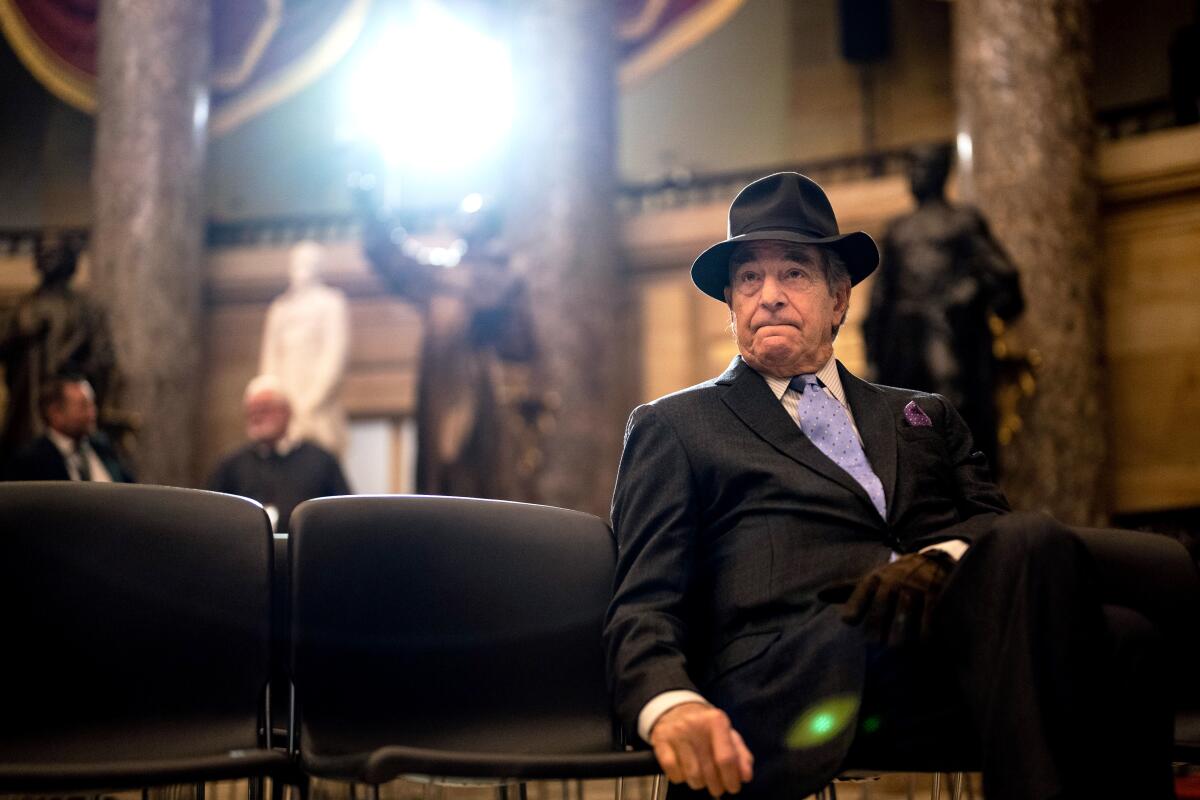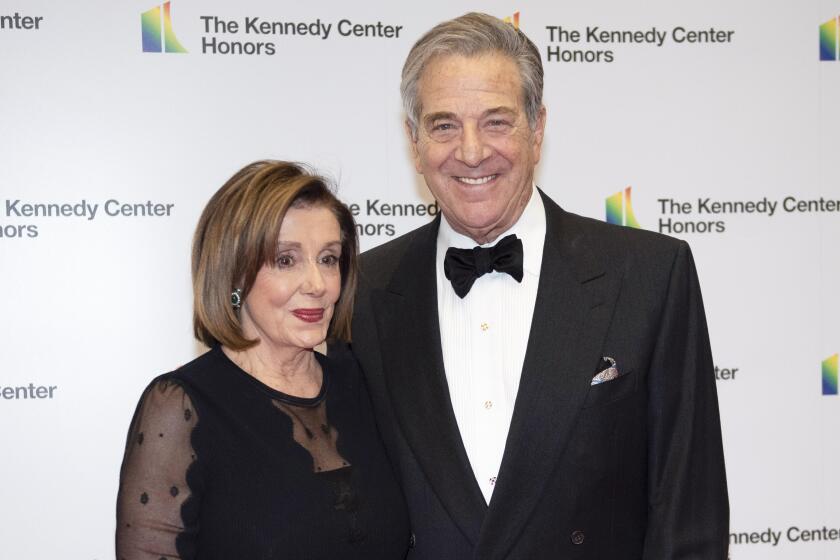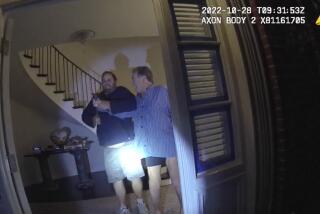Paul Pelosi testifies that he knew he was in ‘serious danger’ before hammer attack

SAN FRANCISCO — Paul Pelosi, husband of former U.S. House Speaker Nancy Pelosi, offered chilling details in federal court on Monday of the night he was allegedly attacked and bludgeoned with a hammer by a man now on trial for attempted kidnapping and assault.
Paul Pelosi, 83, took the stand on the second day of the federal trial against David DePape, who faces federal charges for attempting to kidnap the Democratic congresswoman and assaulting her husband with the intent to interfere with the lawmaker’s official duties or retaliate against her.
The federal trial of David DePape, the man accused of attacking Paul Pelosi and attempting to kidnap Rep. Nancy Pelosi, begins Thursday in San Francisco.
DePape, 43, is accused of traveling from his Richmond residence to the Pelosis’ San Francisco home the early morning of Oct. 28, 2022, in search of the lawmaker, allegedly with plans to hold her hostage and question her regarding far-right conspiracy theories involving the Democratic Party and a list of politicians and public figures.
Instead of finding Nancy Pelosi, who was in Washington at the time, DePape wandered through the quiet Pacific Heights home before stumbling upon a bedroom with her husband sleeping inside.
“The door opened and a very large man came in, with a hammer in one hand and some ties in the other hand,” Paul Pelosi testified. “And he said ‘Where’s Nancy?’ And I think that’s what woke me up.”
Until then, it was a typical evening.
Paul Pelosi told jurors he’d gone to dinner that night in San Francisco. He went to sleep as usual between 11:30 p.m. and midnight, bringing a cup of ice water he took to bed each evening. He didn’t set the alarm system, which the family only used when they were out of town, because it’s sensitive and will go off easily with people in the home.
A couple of hours later, Paul Pelosi woke up in “tremendous shock” after realizing that “someone had broken into the house.”
“And looking at him and looking at the hammer and the ties, I recognized that I was in serious danger,” he said. “And so I tried to stay as calm as possible.”
Paul Pelosi said he told DePape that his wife was in Washington.
“Well then we’re going to have to wait for her,” Paul Pelosi said DePape responded.
DePape told Paul Pelosi that his wife was the “leader of the pack,” and “he had to take her out,” he testified. Because she wasn’t home, Paul Pelosi said DePape told him he had to tie him up and wait for her.
“He had these cords in his hand. I assume that’s what he was going to use,” he said.
Paul Pelosi said he first tried to move toward the elevator outside the couple’s bedroom, which had a telephone inside. But DePape caught on, Paul Pelosi said, so instead he moved toward his bathroom where he charged his cellphone each night.
He called 911, but didn’t feel like he could be honest with the dispatcher about the situation. DePape still had the hammer, and was demanding that Paul Pelosi tell the dispatcher that he was just a friend of the family.

According to his court testimony, Paul Pelosi hung up the 911 call, and tried to reason with the intruder. DePape said he was tired, and wanted to tie Paul Pelosi up so that he could get some sleep. Paul Pelosi suggested the two men walk downstairs, where DePape left his two backpacks and other belongings. Paul Pelosi said he knew that if the police came, they needed to get downstairs where it would be easier to arrest the suspect.
“He said, ‘Oh, the police are going to be here, it’s over for me, I’m going to have to take you out,’ things like that,” Paul Pelosi said DePape told him. “I said ‘No, they’re probably not going to come. They’re probably not going to come.’
“And then the police were at the door.”
Police body camera footage shows Paul Pelosi — holding his cup of water — opening the door with DePape standing next to him. The two were fighting for control of the hammer, which officers ordered them to drop.
DePape instead grabbed it from Paul Pelosi and swung it at his head multiple times, fracturing his skull and causing injuries to his arm and hand. Photo and video evidence shown to the jury on Thursday depict Paul Pelosi lying in a pool of his blood, struggling to breathe as police tackled DePape.
He was hospitalized for more than a week at Zuckerberg San Francisco General Hospital for a fractured skull and other injuries. He received a dozen stitches on the back of his right arm, he said, and his badly damaged left hand was also treated. Paul Pelosi told the jurors that the plastic surgeon was able to reconstruct his hand and avoid doing skin grafts, while his head injury recovery included regaining his balance and “getting my walking back.”
Paul Pelosi recounted the attack as his daughter, Christine Pelosi, sat in the far back corner of the courtroom and while DePape watched from beside his defense attorneys.
Despite the graphic testimony and evidence, the trial is considered far from an easy assault case. Prosecutors bear the burden of proving that the attack was due to Nancy Pelosi’s role as House Speaker, and that DePape intended to kidnap her after breaking into the lawmaker’s home.
Assistant U.S. Atty. Laura Vartain Horn told the federal court jury in her opening arguments on Thursday that DePape had gone to the couple’s home that early morning with the idea to hold Nancy Pelosi “hostage,” “break her kneecaps” and “teach her a lesson.”
“When the defendant broke into the speaker’s home, he had a plan,” Horn told the jury of 12 men and three women. “It was a violent plan.”
Prosecutors attempted to bolster their argument on Monday when questioning FBI Special Agent Stephanie Minor, who has handled the case over the last year. Minor walked the jurors through a series of videos showing DePape traveling from the East Bay to the Pelosis’ home, and described a list of his internet searches in the days leading up to the attack.
Minor explained how DePape had extensively researched the Pelosi family, along with others on his so-called target list, and paid for a service that provided their emails and home addresses. The prosecution also played a recording of a phone call DePape made to a reporter earlier this year, in which he seemingly apologizes for not being successful in his mission.
“I have an important message for everyone in America. You’re welcome,” he said. “I would also like to apologize...I’m so sorry I didn’t get more of them.”
But federal public defenders Jodi Linker and Angela Chuang have disputed the argument that DePape intended to kidnap Nancy Pelosi or attack Paul Pelosi because of his wife’s official position in Congress.
Instead, they claim that the Pelosi home was the first stop in a broader scheme to end corruption and other offenses he believed were being committed by the Democratic Party and public officials and celebrities.
DePape’s plan was to use Nancy Pelosi to put an end to his QAnon-like theory that Democratic politicians and public officials were abusing and trafficking children, the jury was told.
“This is not a who done it,” Linker told the jury in her opening argument. It was a “why done it,” she said, “and the why matters.”
The assault has inspired additional conspiracies and prompted political attacks against the Pelosi family, including from former President Trump.
“And [Nancy Pelosi’s] against building a wall at our border, even though she has a wall around her house,” Trump said to cheers and hollering during a speech at the California Republican Party’s convention in September. “Which obviously didn’t do a very good job.”
Former President Trump opened California’s Republican Convention with a rambling speech targeting the state and a long list of enemies such as Rep. Nancy Pelosi.
Along with the federal criminal case, DePape faces separate state charges including assault with a deadly weapon, elder abuse, burglary and threats to a public official and their family.
Paul Pelosi said he’s mostly recovered from his injuries, but that he still suffers from lightheadedness and headaches.
“There are still lumps on my head. If I run my fingers, I can still feel dents and lumps,” he said. “They’re not as sensitive to the touch as they were.”
The recovery process was “very painful,” he said. He said that he had not read news related to the incident, nor had he listened to the tapes or watched the videos.
“I’ve tried to put it out of my mind,” he said, taking periodic pauses to maintain his composure.
“I’ve made the best effort I possibly can to not relive this.”
More to Read
Sign up for Essential California
The most important California stories and recommendations in your inbox every morning.
You may occasionally receive promotional content from the Los Angeles Times.













